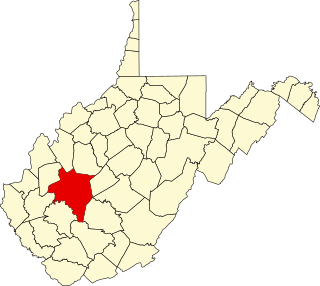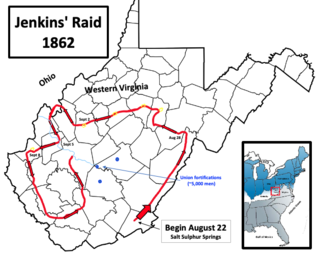
The Battle of Cloyd's Mountain occurred in Pulaski County, Virginia, on May 9, 1864, during the American Civil War. The fight has also been called the Battle of Cloyd's Farm. A Union Army division led by Brigadier General George Crook defeated a Confederate Army consisting of three regiments, one battalion, and Confederate Home Guard. The Confederate force was led by Brigadier General Albert G. Jenkins and Colonel John McCausland. Although the intense fighting portion of this battle may have lasted for only one hour, it was southwestern Virginia's largest fight of the Civil War.

The Battle of Sailor's Creek was fought on April 6, 1865, near Farmville, Virginia, as part of the Appomattox Campaign, near the end of the American Civil War. It was the last major engagement between the Confederate Army of Northern Virginia, commanded by General Robert E. Lee, and the Army of the Potomac, under the overall direction of Union General-in-Chief Lieutenant General Ulysses S. Grant.

The Battle of Charleston was a Confederate victory in Kanawha County, Virginia, on September 13, 1862, during the American Civil War. Troops led by Major General William W. Loring defeated a Union force led by Colonel Joseph Andrew Jackson Lightburn. This battle, which featured extensive use of artillery but few casualties, was the second major fight in Loring's Kanawha Valley Campaign of 1862 that succeeded in driving Union forces out of the Kanawha River Valley. All points in the Kanawha River Valley were in the southwestern part of Virginia at the time of the battle, but are now part of the state of West Virginia.
The 9th West Virginia Infantry Regiment was an infantry regiment that served in the Union Army during the American Civil War.
The 10th Ohio Infantry Regiment was an infantry regiment in the Union Army during the American Civil War. The regiment was also known as the Montgomery Regiment, and the Bloody Tenth. The 10th Ohio Infantry was predominantly recruited from Irish Americans, but had two companies consisting of German Americans.

The 3rd Arkansas Infantry Regiment, commonly known as the "Third Arkansas", was a line infantry formation of the Confederate States Army in the Eastern Theater of the American Civil War.

The 9th Regiment Massachusetts Volunteer Infantry was a military unit from Boston, Massachusetts, USA, part of the Army of the Potomac during the American Civil War. It is also known as "The Fighting Ninth". It existed from 1861 to 1864 and participated in several key battles during the war. The unit is an Irish heritage unit, with many volunteers having been born in Ireland.
The 1st Kentucky Infantry Regiment was an infantry regiment that served in the Union Army during the American Civil War.
The 2nd Kentucky Infantry Regiment was an infantry regiment that served in the Union Army during the American Civil War.
Simmonds' Battery Kentucky Light Artillery was an artillery battery that served in the Union Army during the American Civil War. It was sometimes referred to as the 1st Kentucky Independent Battery, and has the distinction of being the only Kentucky unit in U.S. service to serve in the eastern theater.
The 13th Ohio Infantry Regiment was an infantry regiment in the Union Army during the American Civil War.
The 11th Ohio Infantry Regiment was an infantry regiment in the Union Army during the American Civil War.
Hispanics in the American Civil War fought on both the Union and Confederate sides of the conflict. Not all the Hispanics who fought in the American Civil War were "Hispanic Americans" — in other words citizens of the United States. Many of them were Spanish subjects or nationals from countries in the Caribbean, Central and South America. Some were born in what later became a U.S. territory and therefore did not have the right to U.S. citizenship. It is estimated that approximately 3,500 Hispanics, mostly Mexican-Americans, Puerto Ricans and Cubans living in the United States joined the war: 2,500 for the Confederacy and 1,000 for the Union. This number increased to 10,000 by the end of the war.
The 28th Ohio Infantry Regiment was an infantry regiment in the Union Army during the American Civil War. It was frequently referred to as the 2nd German Ohio Regiment.

The 45th New York Infantry Regiment, also known as the 5th German Rifles, was an infantry regiment that served in the Union Army during the American Civil War. It was composed almost entirely of German immigrants. Formed approximately five months after the start of hostilities, the unit's service spanned almost the entirety of the war, and it saw action in several of the war's noteworthy battles, in both the Eastern and Western Theaters.

The 82nd New York Infantry Regiment, the "Second Militia," "Second Regiment N. Y. S. Light Infantry," or "State Guards", was an infantry regiment of the Union Army during the American Civil War.

The Battle of Lewisburg occurred in Greenbrier County, Virginia, on May 23, 1862, during the American Civil War. A Union brigade commanded by Colonel George Crook soundly defeated a larger Confederate force commanded by Brigadier General Henry Heth. Panicked Confederate forces escaped by crossing and burning a bridge across the Greenbrier River.

The Kanawha Valley Campaign of 1862 was Confederate Major General William W. Loring's military campaign to drive the Union Army out of the Kanawha River Valley during the American Civil War. The campaign took place from September 6 through September 16, 1862, although an important raid that had impact on the campaign started on August 22. Loring achieved success after several skirmishes and two battles, and Union troops retreated to the Ohio River and the safety of the state of Ohio.

The Battle of Fayetteville occurred in Fayette County, Virginia, on September 10, 1862, during the American Civil War. A Confederate Army, consisting of multiple brigades commanded by Major General William W. Loring, drove away a Union brigade commanded by Colonel Edward Siber. The battle is part of the Kanawha Valley Campaign of 1862.

Jenkins' Trans-Allegheny Raid was a Confederate cavalry expedition in the American Civil War that took place in Western Virginia and Ohio during August and September 1862. The raid was led by Brigadier General Albert G. Jenkins, and it started on August 22 as a preliminary step in Confederate Major General William W. Loring's military campaign to drive the Union Army out of the Kanawha River Valley. That campaign, known as the Kanawha Valley Campaign of 1862, took place from September 6 through September 16. The purpose of Jenkins' raid was to get behind the Union Army outposts located near the beginning of the Kanawha River, and cut off their main route of retreat to the safety of Ohio.










